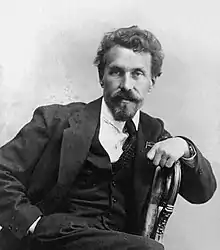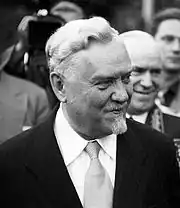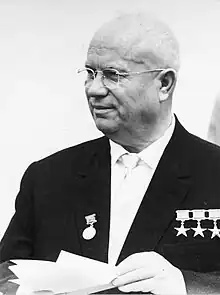Gosbank
Gosbank (Russian: Госбанк, Государственный банк СССР, Gosudarstvenny bank SSSR—the State Bank of the USSR) was the central bank of the Soviet Union and the only bank in the entire country from 1922 to 1991. Gosbank was one of the three Soviet economic authorities, the other two being "Gosplan" (the State Planning Committee) and "Gossnab" (the State Committee for Material Technical Supply). The Gosbank closely collaborated with the Soviet Ministry of Finance to prepare the national state budget.

.svg.png.webp) | |
| Headquarters | 12 Neglinnaya str., Moscow, Soviet Union |
|---|---|
| Established | 1922 |
| Dissolved | 26 December 1991 |
| Central bank of | |
| Currency | Soviet ruble SUR (ISO 4217) |
| Preceded by | State Bank of the RSFSR State Bank of the Russian Empire (1860–1917/1922) |
| Succeeded by | Bank of Russia National Bank of Ukraine (1991–present) |
Foundation
| Part of a series on |
| Soviet economics |
|---|
The foundation of the bank was part of the implementation of the New Economic Policy. On 3 October 1921, the All-Russian Central Executive Committee (VTsIK), passed a resolution for the founding of the State Bank of the Russian Soviet Federative Socialist Republic. This was followed by a similar resolution passed by Sovnarkom on 10 October 1921. It began operations on 16 November 1921. In February 1922 Lenin described the State Bank as "a bureaucratic paper game", comparing it to a Potemkin village in a letter to Aron Sheinman whom he accused of "Communist-mandarin childishness".[1] In 1923 it was transformed into the State Bank of the USSR. It was placed under the jurisdiction of Narkomfin.[2] The Soviet state used Gosbank, primarily, as a tool to impose centralized control upon industry in general, using bank balances and transaction histories to monitor the activity of individual concerns and their compliance with five-year plans and directives. Gosbank did not act as a commercial bank in regard to the profit motive. It acted, theoretically, as an instrument of government policy. Instead of independently and impartially assessing the creditworthiness of the borrower, Gosbank would provide loan funds to favored individuals, groups and industries as directed by the central government.[3]
In 1931 Boris Berlatsky, a senior official of the State Bank was put on trial for wrecking as part of the 1931 Menshevik Trial.[4]
Daughters or "bins of the motherland"
Beginning in 1921 in Paris and prior to his death, Leonid Krasin created the first state controlled Soviet overseas bank. It was one of five "daughter" (Russian: "дочек") banks or "motherland bins" or "bins of the motherland" (Russian: Закрома Родины) which were established in Paris (1921) as the Commercial Bank for Northern Europe (French: Banque commerciale pour l'Europe du Nord) BCEN-Eurobank, in London as part of the Moscow Narodny Bank, in Vienna (1974) as the Donau Bank AG, in Frankfurt am Main as the Ost-West Handelsbank (OWH), and in Luxembourg (1974) as the East-West United Bank. In order to financially assist Communist Parties, anti-imperialism, and pro national liberation movements worldwide, these banks acted as subsidiaries or "daughters" to the "mother" bank or Gosbank, which was the central bank of Russian Soviet Federative Socialist Republic (Russia) from 1921-1922 and the Soviet Union from 1923-1991.[5][6][7][lower-alpha 1][lower-alpha 2]
In 1992 after the end of the Soviet Union, the Paris daughter bank BCEN-Eurobank had bad loans with Cuba, Morocco, and Mauritania and received a "silver plater" infusion of capital from Gosbank through a "participatory credit" (Russian: партисипационный кредит) of $1080.2 billion in various currencies.[5][lower-alpha 3]
The former Communist Party of the Soviet Union (CPSU) funds flowed through these daughter banks to overseas locations during the 1990s looting of Russia.[5]
After the collapse of the Soviet Union, these daughter banks were absorbed into the VTB network and are very closely associated with the Bank of Russia (Russian: Банк России) which was the successor to Gosbank.[5][11]
Perestroika
As part of Mikhail Gorbachev's perestroika program, other banks were formed, including; "Promstroybank" (USSR Bank of Industrial Construction), "Zhilstoybank" (USSR Bank of Residential Construction), "Agrobank" (USSR Agricultural Bank), "Vneshekonombank" (USSR Internal Trade Bank), and "Sberbank" (USSR Savings Bank). "Sberbank" continues to this day as one of Russia's largest banks, retaining senior ex-Gosbank personnel and most of the present Russian government's banking business.
Senior executives
This is the list of the Chairmen of the Board of the State Bank.[2][12]
The Chairman was appointed by the Premier of the Soviet Union.
| № | Name (governor) | Photo | Term of office | Appointed by | |
|---|---|---|---|---|---|
| Start of term | End of term | ||||
| 1 | Aron Sheinman[2] | .svg.png.webp) |
1921 | 1924 | Vladimir Lenin |
| 2 | Nikolai Tumanov | .svg.png.webp) |
March 5, 1924 | January 16, 1926 | Alexei Rykov |
| 3 | Georgy Pyatakov |  |
April 19, 1929 | October 18, 1930 | |
| 4 | Moissei Kalmanovich | .svg.png.webp) |
October 18, 1930 | April 4, 1934 | Vyacheslav Molotov |
| 5 | Lev Maryasin | .svg.png.webp) |
April 4, 1934 | July 14, 1936 | |
| 6 | Solomon Kruglikov | .svg.png.webp) |
July 14, 1936 | September 15, 1937 | |
| 7 | Alexey Grichmanov |  |
September 15, 1937 | July 16, 1938 | |
| 8 | Nikolai Bulganin | October 2, 1938 | April 17, 1940 | ||
| 9 | Nikolai K. Sokolov | .svg.png.webp) |
April 17, 1940 | October 12, 1940 | |
| 10 | N. Bulganin | October 12, 1940 | May 23, 1945 | Joseph Stalin | |
| 11 | Yakov Golev | .svg.png.webp) |
May 23, 1945 | March 23, 1948 | |
| 12 | Vasily Popov | .svg.png.webp) |
March 23, 1948 | March 31, 1958 | |
| 13 | N. Bulganin |  |
March 31, 1958 | August 15, 1958 | Nikita Khrushchev |
| 14 | Alexander Korovushkin | .svg.png.webp) |
August 15, 1958 | August 14, 1963 | |
| 15 | Alexey Poskonov | .svg.png.webp) |
1963 | 1969 | |
| 16 | Miefodiy Svieshnikov | .svg.png.webp) |
1969 | 1976 | Alexei Kosygin |
| 17 | Vladimir Alkhimov | .svg.png.webp) |
October 11, 1976 | January 10, 1986 | |
| 18 | Viktor Dementsev | .svg.png.webp) |
January 10, 1986 | August 22, 1987 | Nikolai Ryzhkov |
| 19 | Nikolai Garetovsky | .svg.png.webp) |
August 22, 1987 | June 7, 1989 | |
| 20 | Viktor Gerashchenko |  |
June 7, 1989 | August 26, 1991 | Valentin Pavlov |
| 21 | Andrei Zverev | .svg.png.webp) |
August 26, 1991 | December 20, 1991 | Ivan Silayev |
Notes
- To process transactions with Russia and later the Soviet Union after 1923, the Swedish banker Olof Aschberg established a Russian commercial bank in Berlin (1920) as the Garantie und Kreditbank für den Osten (Garcrebo) and the Russian commercial bank (Russian: Роскомбанк) in Moscow (1922) which later became a Soviet joint stock bank named the "Foreign Trade Bank of the USSR" (1924) or the Vneshtorgbank (Russian: Внешторгбанк) which was renamed the "Bank for Foreign Economic Affairs of the USSR" (1988) or Vnesheconombank (Russian: Внешэкономбанк) which was renamed VEB (17 May 2007).[8] Garcrebo conducted transactions between the Soviet Union and both Germany and the United States. In Berlin, the Garantie und Kreditbank für den Osten remained open after Hitler took office because of extraterritoriality and operated until 22 June 1941 when Nazi Germany attacked the Soviet Union to start the Great Patriotic War. After the war as a state controlled Soviet overseas bank under Gosbank, the Garantie und Kreditbank AG (Garkrebo) replaced the Garantie und Kreditbank für den Osten (Garcrebo) with approval from Vasily Sokolovsky on 27 May 1945.[9]
- To allow for a large amount of gold trading between the Soviet Union and the West because the Soviet Union had very little foreign currency reserves, Vneshtorgbank established a Soviet bank in Zurich (June 1966) as the Wozchod Handelsbank (English: Wozchod Handels Bank of Zurich) but its license was suspended in 1985 due to irregularities which were resolved in 2014.[10]
- In 1993, BCEN-Eurobank was the main shareholder of its daughter bank Eurofinance which was a "granddaughter" (Russian: внучка) bank to the Bank of Russia.[5]
References
- Lenin, Vladimir (1922). Letter to A. L. Sheinman. Progress Publishers. Retrieved 26 May 2015.
- "The State Bank of the USSR". Bank of Russia Today. Bank of Russia. Retrieved 26 May 2015.
- Russia's Road To Corruption
- Jasny, Naum (1972). Soviet Economists of the Twenties. London: Cambridge University Press. ISBN 9780521083027.
- Сухотина, Инна (Sukhotina, Inna) (10 November 2003). "Сколько стоит приданое "дочек" Банка России?" [How much is the dowry of the "daughters" of the Bank of Russia?]. «Российская газета» (Rossiyskaya Gazeta) (in Russian). Archived from the original on 29 November 2003. Retrieved 25 March 2021.
{{cite news}}: CS1 maint: multiple names: authors list (link) - "Экономическая летопись России: советских и российских банков за границей. АНО "Экономическая летопись". Воспоминания очевидцев. Документы. Том 1" [Economic chronicle of Russia: Soviet and Russian banks abroad. ANO "Economic Chronicle". Memoirs of eyewitnesses. Documents. Volume 1] (PDF). VTB website (in Russian). Moscow. 2007. Archived from the original (PDF) on 29 March 2017. Retrieved 25 March 2021.
- Овчинников, О. (Ovchinnikov, O.) (8 November 2000). "ЦБ - центральный Банд ..." [Central Bank - Central Gang ...]. Агентство федеральных расследований "FreeLance Bureau" (FLB) (flb.ru) (in Russian). Retrieved 10 April 2021.
{{cite news}}: CS1 maint: multiple names: authors list (link) Alternate archive - "Vnesheconombank history". Vnesheconombank website. 2006. Archived from the original on 19 May 2007. Retrieved 25 March 2021.
- Pohl, Manfred (1 January 1975). Die Finanzierung der Russengeschäfte zwischen den beiden Weltkriegen. Die Entwicklung der 12 großen Rußlandkonsortien [The financing of Russian business between the two world wars. The development of the 12 large Russian consortia.] (in German). Frankfurt am Main: Fritz Knapp Verlag. ISBN 978-3781901643.
- "SCHWEIZ / SOWJET-BANK: Morgenröte AG" [SWITZERLAND / SOVIET BANK: Dawn AG]. Der Spiegel (in German). 19 September 1966. Archived from the original on 5 April 2015. Retrieved 25 March 2021.
- "VTB Group completes the merger of its European operations under one license". VTB website. 9 January 2018. Archived from the original on 23 October 2020. Retrieved 25 March 2021.
- "ГОСУДАРСТВЕННЫЙ БАНК СССР" [State Bank of the USSR]. СОВНАРКОМ, СОВМИН, КАБМИН СССР 1923-1991 гг. (SOVNARKOM, SOVMIN, CABMIN of the USSR 1923-1991) (in Russian). Archived from the original on 14 April 2016. Retrieved 24 January 2020.
External links
- Soviet Banking System, Pekka Sutela, Answers.com (accessed 2012-08-02)
- Nikolai Rovinsky (1944). "The State Budget of the USSR". (in Russian)